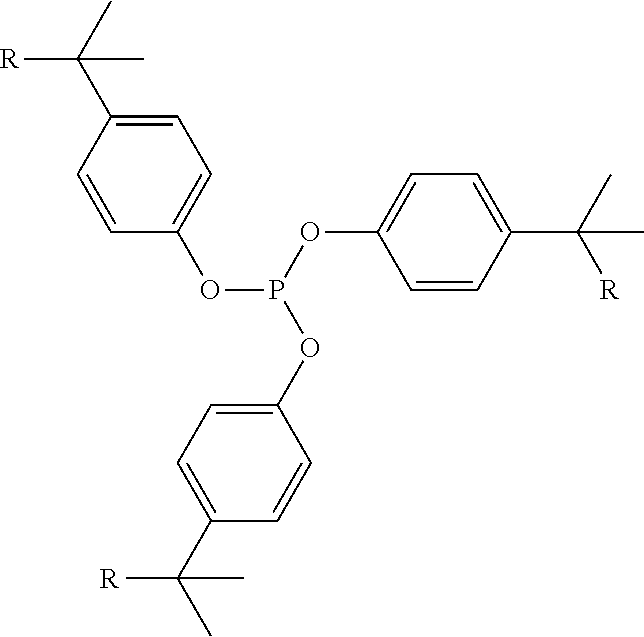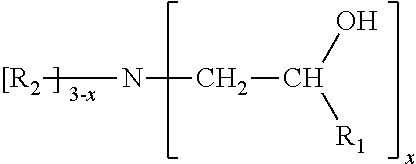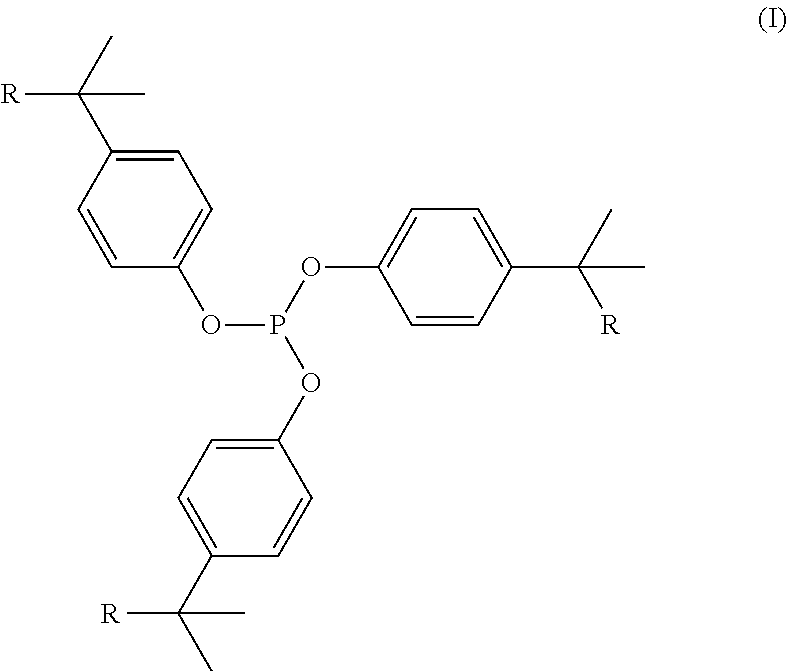Phosphite compositions
a composition and phosphite technology, applied in chemical inhibitors, chemical apparatus and processes, etc., can solve the problems of damage to processing equipment, affecting the performance of certain polymers and under certain conditions, and difficult handling, so as to improve the stability of melt flow, less discoloration, and less melt processing color
- Summary
- Abstract
- Description
- Claims
- Application Information
AI Technical Summary
Benefits of technology
Problems solved by technology
Method used
Image
Examples
example 1
[0132]Polyethylene compositions were prepared by blending a metallocene linear low density polyethylene / hexene copolymer, i.e., m-LLDPE, d=0.918, C6, 1MFI=1.0, with 500 ppm of the phenolic antioxidant, octadecyl (4-hydroxy-3,5-di-tert-butyl-phenyl)propionate, and 1500 ppm of the phosphite and phosphite / amine compositions as shown in table 1.
[0133]The formulations are melt compounded in a single screw extruder at 190° C. under nitrogen.
[0134]The hydrolytic stability of the phosphites on the compositions is tested by exposing the samples to 90% RH @ 40° C. and measuring the active phosphorus still present in the compositions at various intervals. The % retained active phosphorus is the amount of antioxidatively active phosphorus compounds present based on the amount originally added as determined by thoroughly extracting the compositions and analyzing the extracts by chromatography to determine the amounts of antioxidant phosphorus species present.
[0135]The results are shown in Table ...
example 2
[0137]Compositions of m-LLDPE from above, Comp 1, 3, 5, 7, 9* and 11* are multiply extruded on a single screw extruder at 230° C. Samples of first, third and fifth pass extrudate are collected and tested for melt flow retention and color formation. The initially compounded compositions of Example 1 are used as the 0 pass sample. In addition, samples from the first pass extrusion are tested for gas fade, i.e., color development during exposure to oxides of nitrogen at 60° C. All tests are run under standard industry conditions, as previously identified herein.
[0138]Melt flow retention was nearly identical for each composition tested.
[0139]Color formation during extrusion was determined from 1.5 mm thick test samples. As can be seen in Table 2, compositions containing liquid phosphite formulations 3, 5, and 7, and the solid phosphite formulations of the invention, 9* and 11* exhibit less color development during multiple pass extrusion than tris(2,4-di-t-butylphenyl)phosphite (P1).
TAB...
example 3
[0141]Polyethylene compositions similar to those above, but with the load levels of the phosphites altered to provide the same amount of phosphorous that is introduced by 1500 ppm of tris(2,4-di-t-butylphenyl)phosphite. The compositions were prepared by blending the same metallocene linear low density polyethylene / hexene copolymer, i.e., m-LLDPE, d=0.918, C6, MFI=1.0, with 500 ppm of the phenolic antioxidant, octadecyl (4-hydroxy-3,5-di-tert-butyl-phenyl)propionate, and the amounts of phosphite and phosphite / amine compositions as shown in Table 4. The formulations are initially melt compounded in a single screw extruder at 190° C. under nitrogen and then extruded on a single screw extruder at 230° C. as in Example 2.
[0142]Melt flow retention was again extremely similar for each composition tested.
[0143]Color formation during multiple extrusion and Gas Fade data were obtained as above and the results shown in Table 4 and 5. Again, the compositions containing phosphite compositions of...
PUM
| Property | Measurement | Unit |
|---|---|---|
| melting point | aaaaa | aaaaa |
| wt % | aaaaa | aaaaa |
| temperature | aaaaa | aaaaa |
Abstract
Description
Claims
Application Information
 Login to View More
Login to View More - R&D
- Intellectual Property
- Life Sciences
- Materials
- Tech Scout
- Unparalleled Data Quality
- Higher Quality Content
- 60% Fewer Hallucinations
Browse by: Latest US Patents, China's latest patents, Technical Efficacy Thesaurus, Application Domain, Technology Topic, Popular Technical Reports.
© 2025 PatSnap. All rights reserved.Legal|Privacy policy|Modern Slavery Act Transparency Statement|Sitemap|About US| Contact US: help@patsnap.com



